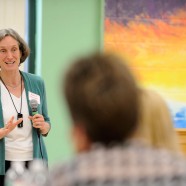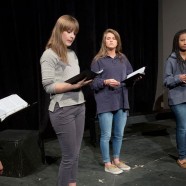A Catalyst at Google: Annie Argues for Real Conversations – Annie Jean-Baptiste ’06
Silicon Valley, arguably the most innovative corner of the planet, is also famously—and perhaps resolutely—homogeneous. The Valley’s mostly male and mostly white and Asian tech workforce unremittingly turns out life-changing tools. Can the mix of minds and hearts that created today’s constantly evolving reality come up with inventions that will work for the next billion users, and solve the problems of our battered planet as well? “Tech companies, regardless of their size, are focused on these ‘next billion users,’” says Annie Jean-Baptiste, a diversity programs manager for...
Read MoreLitigating the Right to Marry – Chris Dusseault ’87
You might predict that a debater at Milton and then Yale would turn up as a lawyer. Chris Dusseault claims an even tighter overlap between his love of music and singing at both those schools and his distinction as a litigator. “Reading your audience, understanding them, what they’re receiving and what they’re not, is much the same as looking a judge and jury in the eye. You come into the courtroom with one conception of how it should go—‘this is what I intended’—but is it working? You need to pay attention to what is resonating and what is not. Because at the end of the day,...
Read MoreWhat Don’t You Understand? Making Videos that Tackle the Issues that Confound Us. – Joe Posner ’03
The first of Joe Posner’s videos to go viral, he explains, was a robust, animated description of Europe’s austerity programs—all in about five minutes. He pitched the project, earned a grant from his alma mater, Brown, and collaborated with political economist Mark Blyth to render scholarly ideas about austerity in an accessible, entertaining video. That was 2009. Today, Joe’s videos deliver facts-in-context at Vox.com, where his approach to creating video matches the mission of the Vox digital platform. Vox.com aims to “explain the news and the world around you.” Videos and...
Read MoreEducation. Especially Rural and Public. – Rebecca Holcombe ’84
The map of Vermont’s school districts—more than 270—on Dr. Rebecca Holcombe’s office wall resembles a patchwork quilt. Rebecca is responsible for this mix of colors and overlapping diagonal lines, this complicated school system. A passionate supporter of public schools, Rebecca became Vermont’s Secretary of Education in January 2014. “Nothing is more important than public education,” says Rebecca. “If we cannot help children develop their voices and participate in civic life, help them make good decisions for our communities and give them the tools they need to be part of our...
Read MoreWhat Is the Real Safe?
In the black box, six students shift quietly about the stage, taking positions to give public voice to the raw, or eloquent, or plaintive comments that emerged during more than 30 interviews. The actors, in their dark or neutral street-wear, recede physically, which isolates and emphasizes their words slicing through the air, riveting the audience. The script, which they sculpted from their transcribed interviews, sketches vulnerability in different shapes and sizes. It uses their narrators’ exact phrases. “Narrators” are those people who answered student questions with startling...
Read MoreKnow Thyself: An Approach to Getting There
In the student lounge of Ware Hall one morning in late May, seventh graders were piecing together snack “necklaces” to represent what they’d learned about themselves. They’d just completed year one of the Middle School’s 360 program. A mini-Saltine cracker meant they knew their learning style, and could easily articulate it. Gummy candies and fruit loops in different flavors represented auditory, visual and tactile/kinesthetic learning. A Cheerio represented empathy, and a purple gummy ring was the sign of good time management. A Cheez-It indicated that the wearer would rather work...
Read More








